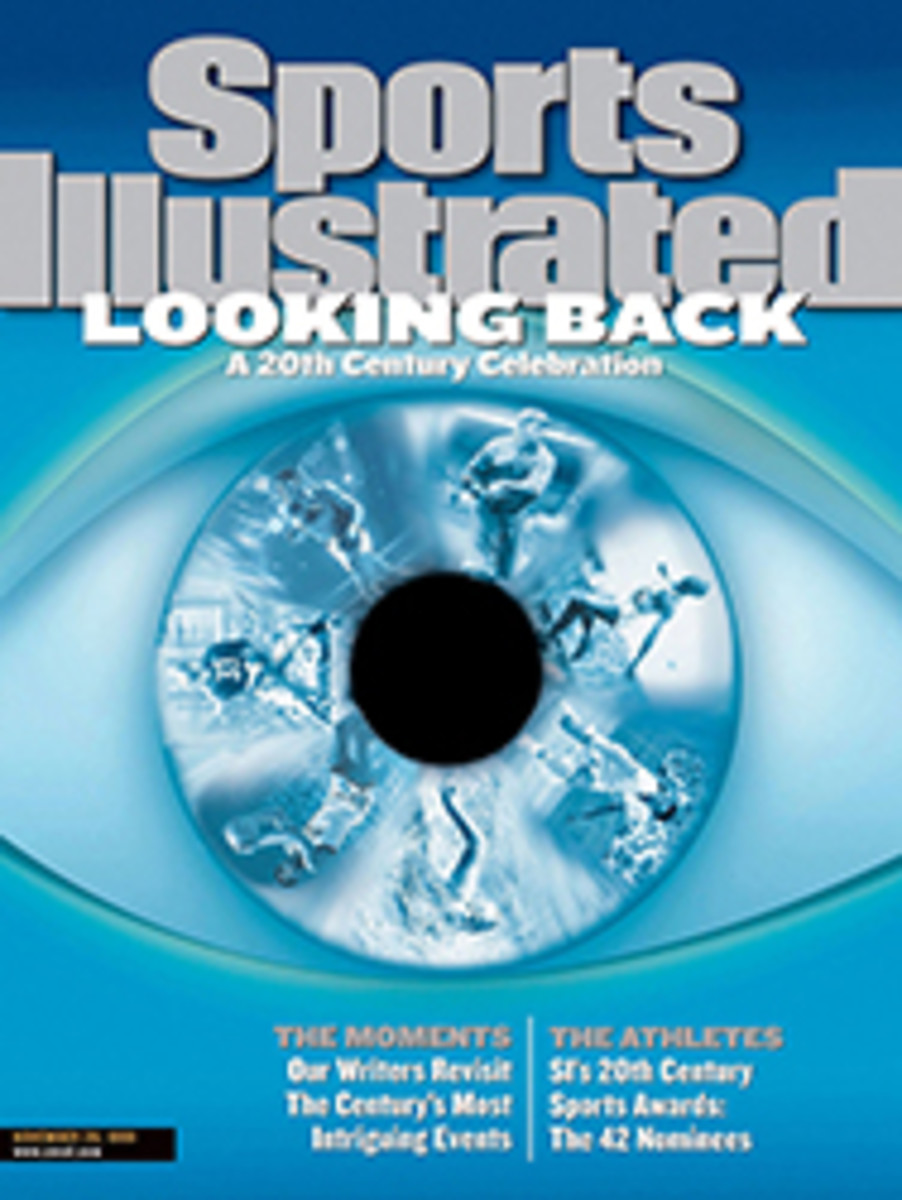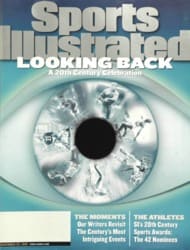
Back Safe On Earth Scott Johnston is firmly in the saddle again after a near fatal plane crash
When the engine sputtered and went quiet, three passengers put
down their playing cards, and the fourth, sprawled across the
backseat, sat up. The pilot, who had flown so much that the
passengers called him Sky King, looked at the fuel gauge, which
showed a quarter of a tank remaining. Odd. He switched to the
left tank, in which he'd saved a small amount of gas. The engine
remained silent. Eight hundred feet in the air, the suddenly
powerless 1973 Cessna 210 began to fall.
You could call it a miracle if Scott Johnston of Australia wins
the world saddle bronc championship at the National Finals Rodeo
(NFR), which will be held Dec. 3-12 at UNLV's Thomas and Mack
Center. But as his wife, Jane, reminds him, maybe the miracle is
that he'll be there at all. The 26-year-old Johnston, who is
fifth on the money list at $71,934 but within reach of No. 1 Rod
Hay, couldn't ride a carousel horse early this year. "It seems
like a long time ago," he says, holding two-week-old Michael,
the youngest of his and Jane's four children, at their home in
DeLeon, Texas.
On Nov. 4, 1998, Johnston was with bareback riders Mark Garrett,
33, and Garrett's brother Marvin, 35; bull rider Thad Bothwell,
30; and the Garretts' friend and longtime pilot, Johnny (Sky
King) Morris, 60, in a borrowed single-engine airplane. They were
en route to the Grand National Rodeo, the last official event of
the regular season, at the Cow Palace in Daly City, Calif.
Johnston was 16th in season earnings, one spot out of a place in
the NFR, but he was optimistic. The horse he'd drawn for his
first-round ride, Ram Power, was a live one.
When the engine quit at 2 p.m., the plane was 70 miles from the
San Carlos, Calif., airport. Morris, who had logged more than
18,000 hours as a pilot, had just flown over the Lodi airport but
didn't have enough speed to turn back. He dropped the plane into
a cluster of oak trees, shearing the wings off, before crashing
into a dry creek bed on the edge of a vineyard. So powerful was
the impact that the prop and engine came loose and flew 35 feet
in front of the rest of the aircraft, which ignited like a
marshmallow.
Bothwell pushed open the cabin door and fell out. Mark Garrett,
the only passenger who had not been wearing a seat belt (he was
the one lying across the backseat) and the only one whose back
was not broken by the impact, dragged his brother from the
copilot's seat to safety. Johnston stumbled out but returned
when he saw that Morris was on fire. Flames from under the dash
had risen up the pilot's legs, then engulfed his hands when he
tried to tamp them out. Mark Garrett attempted to open the
pilot's door but could not. "We have to get Johnny!" Johnston
yelled, and he began working to free Morris of his seat belt. By
the time Mark dragged him clear, Morris had suffered, in
addition to the broken back, burns over 47% of his body and a
severe blow to the head. For 30 minutes Morris kept asking, "Did
everybody make it out?" Everybody did, Mark said. Two weeks
later, Morris died.
The 1999 Professional Rodeo Cowboys Association media guide
features a picture of Johnston on its back cover. He has his
right arm extended behind him at 10 o'clock, parallel to his
horse's bucking legs. The photo's prominent placement is
appropriate; Johnston, Rookie of the Year in '96, is one of
rodeo's top talents. Yet the picture is not of his wildest ride,
and you get the feeling he wishes it were. In discussing the
accident, Johnston drinks four cups of coffee and looks as if
he's about to explode out of his chair. Yes, he wondered if he
was right with the Lord. No, he didn't think he was going to
die. Yes, he thought it eerie to hear branches scraping the side
of the plane. No, he doesn't think about it every day. Johnston
is a doer, not a talker--or a listener, for that matter.
He grew up in Brewarrina, New South Wales, in Australia's remote
southeast interior. Of his family's 20,000-acre ranch, Johnston
says, "It was the smallest place around." That's where his
grandpa Jack rode bucking horses and, bruised and cash-strapped
by the experience, urged his son, John, to avoid the sport. John
listened, but when he tried to pass on the same message to
Scott, it didn't take. At age 17, Scott entered his first rodeo.
He won.
This is the kind of headstrong behavior that his wife, a nurse,
learned to expect after she met him in '92. The first time Jane
watched Scott ride, he got caught in his rigging and was dragged
alongside the horse, which stepped on him repeatedly. Its hooves
ripped off his chaps, jeans and skin. Johnston finally got free,
but instead of counting his blessings and applying his
dressings, he went to his truck for another pair of pants. He
had three more events to ride in. Scott and Jane were married in
'94, traveled the Canadian circuit in '95 and came to the U.S. a
year later when Scott joined the PRCA.
This season Johnston had to buy new equipment. Only two hats,
belonging to Morris and to Marvin Garrett, were spared in the
airplane blaze. Morris and Johnston were believed to be worst
off and were flown by helicopter to the UC Davis Medical Center
in Sacramento. Jane, waiting at the San Carlos airport, was
summoned to the flight school office, where she spoke to Mark on
the phone. The plane had crashed, he said, but everyone was alive.
When Jane arrived at the hospital, Scott grabbed her hand and
before she could panic said, "I'm all right, I'm all right!"
Three days later, his fourth and fifth vertebrae were fused with
two metal rods. The operation went well, but doctors scratched
their heads when they saw Johnston's spine, which had been pushed
back so far it was nearly poking through his skin. They fit him
for a back brace and told him he'd be wearing it for six months.
They weren't even close.
After a 10-day hospital stay in which he played gin rummy with
Marvin (a friend shuttled the cards across the hall), Johnston
went home. Two days later he painted the house. A month after
that he was out of the brace, and 80 days after the crash,
despite strenuous argument from doctors, he began riding again,
at the Southwestern Exposition Livestock Show and Rodeo in Fort
Worth, last Jan. 23. "Proactive insanity," says Dan Benson, a UC
Davis orthopedic surgeon. "It takes four or five months for
fractured vertebrae to heal."
"I thought he was crazy," Marvin Garrett says, "and he is."
"The doctors said to stay as active as possible," Jane says.
"They should have chosen their words more carefully."
On a horse named Doc Holliday, Johnston stayed on eight seconds,
and his 75 was the best score of the night. Since then he has
only gotten better. Last month he won the Coors Showdown in
Phoenix and took fourth at the Grand National, the rodeo he
never made it to last year. Mark Garrett has also qualified for
the NFR. Bothwell and Marvin Garrett haven't but are riding
again. Marvin believes that a higher power was at work during
the crash: that when their plane hit the last tree head-on, 12
feet up, it found two branches outstretched like arms that tried
to catch it. "I think they were put there for that reason,"
Marvin says.
Johnston still flies in small planes--top cowboys enter as many
as three rodeos per day and have little choice but to fly--but
he has one lingering concern. He had no medical insurance last
year (in Australia, a national health plan makes such insurance
unnecessary) and amassed $200,000 in medical bills. Neither a
sponsor, which Johnston has yet to land, nor the Justin Cowboy
Crisis Fund, which helped Johnston while he was sidelined, will
pay his debt. Johnston is still considering whether to bring a
product liability suit against Cessna.
The National Transportation Safety Board has released only its
preliminary findings on the accident, and everyone from Johnston
to Morris's son, Cody, also a pilot, is eager to see the final
report. Was the fuel gauge faulty? How could the plane have
ignited so quickly if it was out of gas?
"I thank God for as far as I've gotten this year," says
Johnston, whose supporters at the NFR will include his parents,
in-laws and two younger brothers, all from Australia, as well as
Jane and the kids. "That I'm still alive, as healthy as I was
before the crash and still able to do my dream. Other than that
I don't really like to think about it."
COLOR PHOTO: DAN HUBBELL Bucking odds The rods in his back haven't hobbled Johnston.
Eight hundred feet in the air, in a suddenly useless 1973 Cessna
210, they began to fall.

